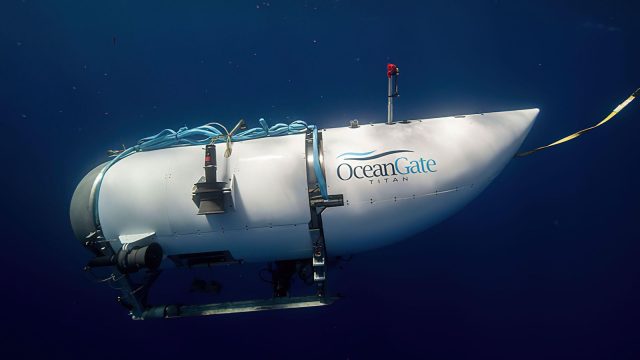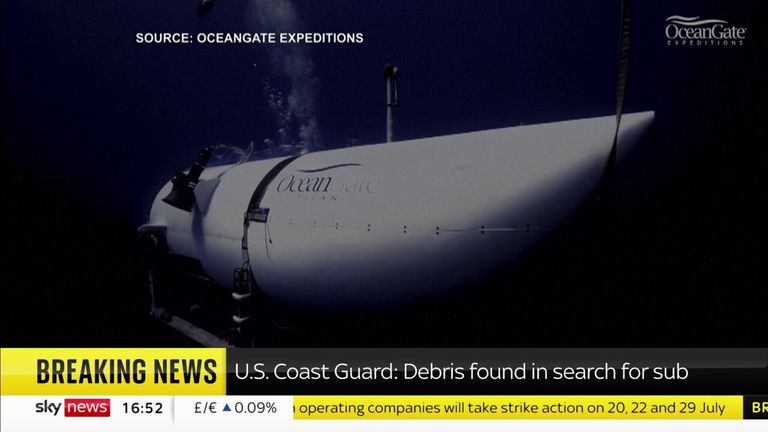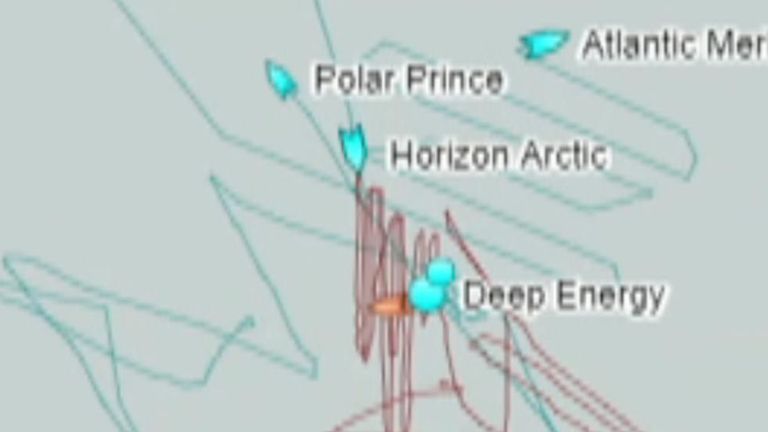A debris field has been discovered within the search area by a remotely operated underwater vehicle near the Titanic, the US Coast Guard has said.
“Experts within the unified command are evaluating the information,” a statement on Twitter added.
A news conference to discuss the findings is scheduled to take place at 8pm UK time tonight.
Coast Guard to make statement – follow live updates
The debris field was found by a remotely operated vehicle deployed by Horizon Arctic, a Canadian vessel.
The ROV, which is equipped with cameras and sonar, had successfully managed to reach the sea floor.
Sky’s US correspondent James Matthews, reporting from Boston, described the updated statement as “significant”.
He added: “The word ‘debris’ doesn’t sound good at all in a situation and at a depth where the water pressure is huge.
“It can do considerable damage to vessels – the like of the Titan – on the seabed, 4,000m (13,123ft) down.
“Should the worst have happened, and that vessel was broken up somehow by the pressures at that depth, the word ‘debris’ would absolutely fit that worst-case scenario.”
It is yet to be confirmed whether the debris is linked to the missing submersible – but nonetheless, it is a potential breakthrough in an increasingly urgent, round-the-clock rescue effort.
Admiral Sir James Burnell-Nugent, former Commander-in-Chief Fleet of the Royal Navy, told Sky News that “the nature of the announcement suggests this debris is in some way connected with the Titan”.
He explained: “There is of course a large debris field around the Titanic – and the various things we’ve seen retrieved from the Titanic have come from the debris field. It covers several hectares.
“But I think if this was Titanic debris, the Coast Guard would have made a distinction in the announcement. I think on balance this is probably grim news and suggests the Titan might have imploded under the immense pressure of the seawater while it was on its way down.”
And David Mearns – a rescue expert who knows two of the men onboard, British billionaire Hamish Harding and French submersible pilot Paul-Henri Nargeolet – told Sky News: “They don’t use phrases like ‘debris field’ unless there’s no chance of a recovery of the men alive.
“A debris field implies a break-up of the submersible … that really sort of indicates what is the worst-case scenario, which is a catastrophic failure and generally that’s an implosion.
“The only saving grace is that it would have been immediate – literally in milliseconds – and the men wouldn’t have known what was happening.”
In an emotive interview, he said his “worst fears have now been realised” – and he had been praying for a different outcome.
“Two friends of mine are gone,” Mr Mearns said.
Titan had disappeared on Sunday in the Atlantic Ocean – 435 miles south of Newfoundland, Canada – during an expedition dive to see the wreck of the Titanic.
Also on Thursday, a deep-sea robot called Victor 6000 headed to the search area. It has remotely controlled arms that can cut cables and perform other manoeuvres to release a stuck vessel, and is able to go deeper than the Titanic itself.
Five men are on board – and alongside Mr Harding and Mr Nargeolet are the British businessman Shahzada Dawood and his son Suleman, alongside OceanGate’s US-based chief executive and founder Stockton Rush.
The US Coast Guard had predicted that the air supply in the vessel would run out at 12.08pm UK time on Thursday.
Ships, planes and underwater craft from multiple countries were deployed to the area with rescuers searching a remote part of the Atlantic Ocean more than twice the size of the US state of Connecticut in waters as deep as 4,020m (13,200ft).










![[VIDEO] Agya Koo celebrates like Cristiano Ronaldo after scoring penalty](https://ghananewss.com/storage/2023/02/BeFunky-collage-2023-02-17T164545.706-scaled-100x75.jpg)









